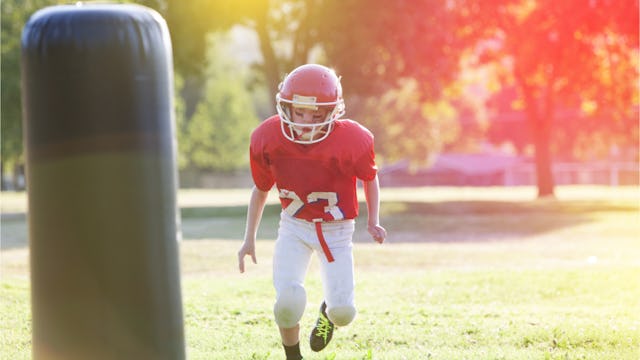I Won't Let My Kid Play Tackle Football, And Science Backs Me Up

The call came in the middle of a hectic morning.
The school nurse was on the other end, and she told me in no uncertain terms that I needed to come to school immediately.
“He has a head injury,” she said.
My son, age 8 at the time, had collided with another boy in gym class. As their heads made direct contact, my son was knocked unconscious for a few seconds.
By the time I got to the nurse’s office, my son had an angry bump the size of a kiwi that was growing bruised and more swollen by the minute. He was groggy and disoriented. And his symptoms got worse from there: vomiting, an inability to walk or hold his weight, lethargy, and confusion. After speaking with our family doctor, we rushed him to the emergency room where they confirmed our suspicions: He had a concussion.
And it took him almost eight weeks to recover.
Eight weeks of headaches, visual disturbances, difficulty with short-term memory and an inability to concentrate. All because he had an accidental encounter with another child.
While our son recovered completely, we have no way to know what kind of long-term damage his injury caused to his growing brain.
Because of our experience and because we witnessed firsthand how debilitating a concussion can be for a child, my husband and I made the decision shortly after his injury to not allow our son to play tackle football. And while he watches from the sidelines at the high school football games in our town, he remembers all too well how hard it was to recover from his brain injury.
And in light of a recent report by the Journal of the American Medical Association, science says my husband and I are not unfounded in our decision to keep our kid from toeing the 50-yard line.
In their study released this week, JAMA reports that scientists examined 111 brains of former professional NFL football players and found evidence of chronic traumatic encephalopathy (CTE) in 110 of the 111 samples.
This is a stunning development, and it should cause parents to evaluate their children’s involvement in full-contact sports like football and boxing.
Because medical talk can be hard to decipher, let’s break it down in simple terms:
CTE is a degenerative brain disorder and has been linked to repeated blows to the head. According to the Alzheimer’s Association, symptoms of CTE can include: memory loss, confusion, personality changes (including depression and suicidal thoughts), erratic behavior (including aggression), problems paying attention and organizing thoughts and difficulty with balance and motor skills.
While CTE can only be definitively diagnosed upon autopsy, there is a direct correlation between repeated head trauma and CTE being found at the time of death.
In JAMA‘s study, 202 brains of former American football players were studied, and 177 were found to have CTE. The brains were donated by families who had witnessed CTE symptoms in their loved ones. The former players ranged from having played in high school, college, and professionally and were a wide age range.
Now, it must be said that, yes, because the brains were donated by concerned families of former football players, the likelihood is higher that CTE would be found in a large portion of the samples. This study cannot be used to prove that CTE is a direct result of football head injuries, but it can be used to further fuel the fire that more data is needed to keep our kids safe on the gridiron.
To date, there are no long-term studies of CTE in the living because to do so would be an undertaking of immense time and expense.
Scientists estimate that a long term study of CTE would cost in the ballpark of $100 million and would take painstaking record-keeping for many years before results would be known.
But the takeaway here is clear: Science is closing in on proving that repeated blows to the head while playing football causes long-term damage to the brain.
Even the NFL is listening to the results of this study.
In a statement to NPR, the NFL states in part, “The medical and scientific communities will benefit from this publication and the NFL will continue to work with a wide range of experts to improve the health of current and former NFL athletes.”
And while NFL commissioner Roger Goodall has committed $100 million dollars of money to help research ways to keep athletes safe on the field, more independently funded studies are needed as well. It’s not enough that an institution that makes its money on the premise that their athletes perform week to week is helping to fund research though. Independent, long-term studies will ensure that not only parents can make informed decisions about football play but also that our kids will be safer when they toss the pigskin during games.
So, what’s a parent of a football-loving boy or girl to do?
Speak up.
Demand that your athlete’s football organization supports CTE research. Sure, fundraise for new football jerseys but also fundraise to help fund the exorbitant expense of researching traumatic brain injuries in our young athletes.
Insist that your child wear proper, up-to-date headgear at every game. No exceptions.
Don’t let your kid play football if he or she has been diagnosed with a concussion. Period. There is nothing to be gained by putting your kid under the Friday night lights before their brain is totally healed and cleared by a doctor. And any coach who pushes you to put your kid back in the game sooner than medically necessary should cause you to pause.
And perhaps most importantly, acknowledge that more and more research is proving that head injuries are a serious problem for our kids, both on and off the field.
This article was originally published on